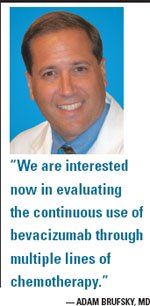Second-line bevacizumab plus chemo improves PFS
The RIBBON-2 trial met its primary endpoint of prolonged progression-free survival.
ABSTRACT: The RIBBON-2 trial met its primary endpoint of prolonged progression-free survival.
SAN ANTONIO-Adding bevacizumab (Avastin) to standard chemotherapy for second-line treatment of metastatic breast cancer significantly improved progression-free survival, according to results from the RIBBON-2 trial.
"We have many good drugs for metastatic breast cancer [MBC], but most of us realize that therapy in 2009, after first-line chemotherapy, is still inadequate," said principal investigator Adam Brufsky, MD, from the University of Pittsburgh. "RIBBON-2 met the primary endpoint, which was to prolong progression-free survival [PFS]. It showed that adding bevacizumab to chemotherapy upon progression improves patient outcomes in second-line treatment, and may represent a new treatment option."

A trio of prior phase III trials (ECOG2100, AVADO, and RIBBON-1) established a consistent improvement in PFS with the addition of bevacizumab to various chemotherapy regimens in the first line.
However, another phase III study (AVF2119) found no increase in PFS for bevacizumab plus capecitabine (Xeloda), although the combination did improve response rates.
RIBBON-2 was designed to further evaluate the clinical benefit of combining bevacizumab with chemotherapy to treat MBC after previous treatment failures. The presentation was the final analysis of PFS and response (by intention-to-treat), and the interim analysis of overall survival (OS), with 57% of the required deaths (SABCS 2009 abstract 42). In the study, 684 previously treated HER2-negative MBC patients were randomized to a standard chemotherapy regimen involving a taxane, gemcitabine (Gemzar), capecitabine, or vinorelbine (Navelbine) with placebo or bevacizumab 15 mg/kg every three weeks or 10 mg/kg every two weeks, depending on the chemotherapy backbone.
Median PFS, the primary endpoint, was significantly improved with the combination of bevacizumab and chemotherapy, from 5.1 months with chemotherapy alone to 7.2 months, which was a 22% reduction in the risk of progression, a highly significant improvement (P = .0072), Dr. Brufsky said.
Response rates were also improved, from 28.5% with chemotherapy alone to 37.3% with the combination. Median OS, which is still premature, was improved from 16.4 to 18.0 months and one-year survival was 66.2% and 69.5%, respectively. These differences were not statistically significant.
When patients were stratified according to the chemotherapy backbone, "the results were fairly interesting," Dr. Brufsky added, although the analysis is exploratory and not powered for statistical significance.

The hazard ratio for benefit with the combination was 0.64 for taxane-based therapy and 0.73 for capecitabine-based therapy, but it was 0.90 with gemcitabine and was actually unfavorable with vinorelbine, at 1.42, he said.
"This is exploratory, with small numbers of patients, but bevacizumab paired with gemcitabine or vinorelbine had no benefit," he noted. In fact, the PFS was numerically worse with vinorelbine plus bevacizumab compared with vinorelbine alone: 5.7 vs seven months. "But we have to point out these numbers are very small, so we cannot make much of these differences at this time," he said.
The toxicity profile was predictable, with grade 3 or higher events observed in 35% of the patients who received the combination and in 23% of those who received chemotherapy alone. Adverse events leading to discontinuation were observed in 13% and 7%, respectively.
"We now have compelling data that this combination is clearly beneficial first line and probably second line," Dr. Brufsky concluded. "We are interested now in evaluating the continuous use of bevacizumab through multiple lines of chemotherapy, which will be the subject of the RIBBON-3 trial."
Results from RIBBON-2 provide evidence that "you don't absolutely have to give bevacizumab as your first therapy. You can give it with your first therapy, or your second therapy," commented Eric Winer, MD. "It is a drug that does not produce a survival benefit, but does result in better tumor control," added Dr. Winer, who is director of the Breast Oncology Center at Boston's Dana-Farber Cancer Institute.